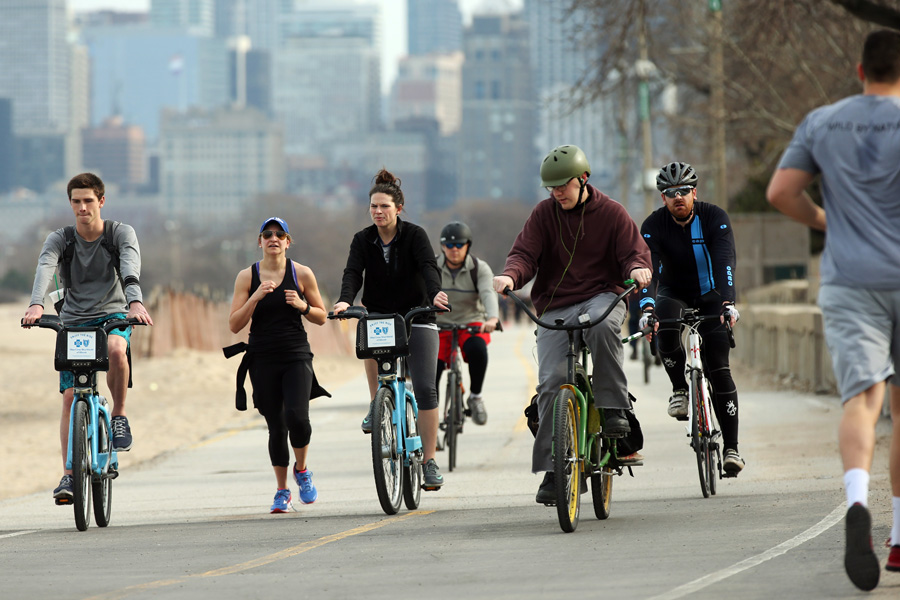The Chicago Lakefront Trail is one of the city’s modern marvels, a miracle of planning and leadership right up there with the ’96 Bulls and the reversal the Chicago River. And it continues to improve with projects like the Navy Pier flyover and the addition at Fullerton Avenue.
But it can also be a hot mess once runners, Rollerbladers, dog walkers, tourists, and of course cyclists are all fighting over the same six feet of asphalt.
It doesn't have to be that way. Here are some tips to ensure you—and everyone else—enjoys the lakefront to its fullest.
Chill Out and Enjoy the Ride
Contrary to popular belief, it’s not a bike path. It’s a multi-use path. And as the users at the top of the food chain, cyclists bear the most responsibility to keep things safe and friendly. If you find yourself always hollering for people to get out of your way, the problem might be you. Try slowing down and being patient.
Speaking of hollering: There are two schools of thought on whether cyclists should call out "on your left" when passing others. I happen to feel this often does more harm than good. You'd be amazed how many people hear "on your left" and interpret it as "please move to your left." Most of the time these announcements are simply unnecessary and just makes everyone's park experience more unpleasant and aggressive. That said, a polite and well-timed call-out or ring of the bell can be useful when used sparingly, such as in tight quarters or if you suspect the person ahead might be changing direction.
Expect the Unexpected
Always be scanning for potential dangers. That child ahead? Have a plan for when she darts across the path. That runner approaching the mile marker? Expect him to make a sudden U-turn. That volleyball game? Be ready for when that serve comes at your head. One of these days one of those things will happen. Be alert for when it does.
Be Ready for a Flat
Unless you're equipped to handle it, a flat on the lakefront could mean a very long walk—or expensive cab ride—to the nearest bike shop. If you're lucky you'll be close to Lakeshore Bike, just north of Addison.
Avoid any walk of shame by always having with you a spare tube, tire levers, and an inflation device. (Like bike messenger Nico Deportago-Cabrera, I prefer an old-fashioned pump over CO2 cartridges.) A flat doesn't have to be a calamity. It should be no more than a 10-minute break.
If you're not comfortable changing a flat, practice at home. There are plenty of video tutorials online. At the very least, travel with a bike tube. That way if a Samaritan comes to your aid, they aren't out a tube of their own.
Stay Informed
The Active Transportation Alliance helps crowdsource path conditions with its @activetransLFT Twitter account, and each month it publishes a list of runs and other events that may interfere with your ride.
Practice Stopping in a Hurry
Sooner or later someone's going to dart in front of you and you'll need to come to a quick halt. Here are two things to remember: Most of your braking power is in your front brake—it's physics! But slamming that brake hard could send you over your handlebars, so at the same time that you're braking, shift your weight backwards by stretching your arms and moving your butt back. Perfect this technique by practicing in a parking lot and it could one day save your neck—literally.
Maybe Take Your Training Elsewhere
The lakefront is a tempting destination for serious athletes. The scenery is gorgeous, the trail is smooth, and there are no cars or stop signs to interrupt your flow. But during peak times, the path is simply too crowded to attempt any riding that raises your heartbeat. Go on a hammerfest during evenings or weekends and you're asking for trouble.
Which is not to say it can't be done. I was a competitive cyclist for 10 years, but my workouts were exclusively in the morning. And if my routine included speedwork, I took it south of the Museum Campus, where it was even less crowded.
If mornings don't work, hook up with one of the many groups that head north up Sheridan Road through the northern suburbs. My cycling team, XXX Racing-Athletico, hosts a Saturday morning ride that anyone is welcome to join in order to learn the ropes.
And maybe rethink those aerobars, no matter how important you think they are to your triathlon prep. Aerobars are great for time trials, when you're riding in a straight line in a controlled environment. They're less appropriate on the windy path, where at any moment you may need to swerve or stop on a dime.
Don't Be a Wheel Sucker, and Don’t Paceline
By riding directly behind another cyclist, you get the aerodynamic benefit of being in their draft. Suddenly you barely have to work to keep up. But it's poor etiquette to do this behind someone you don't know. It's kind of like jumping into someone else’s car and expecting a free ride. It can also be dangerous if the person doesn't know you're there.
Even if you do know the other rider or riders you're drafting off of, this isn't advised in the tight quarters on the lakefront. That feeling when a car buzzes past you, seemingly inches away? That's how it feels to pedestrians or slower cyclists when a paceline of bikes blasts past. You may as well be a freight train. Save the pacelines for the open road.
Happy trails!




